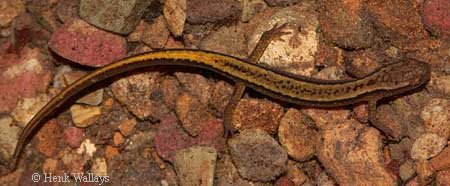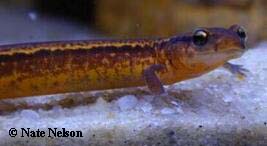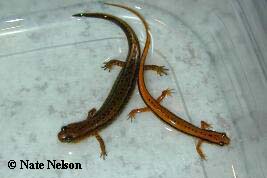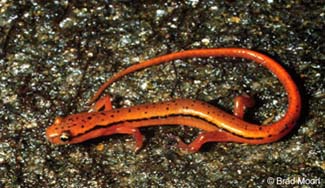| Eurycea
bislineata Eurycea cirrigera Eurycea wilderae Eurycea junaluska | |||||||||
| Two-lined and Junaluska Salamanders | |||||||||

|
|
||||||||
| Eurycea bislineata |
Description:
Two-lined salamanders are a closely related complex of small (up to 12 cm in length), slender salamanders that occur in the eastern half of North America. Currently there are three recognized species, but there is still debate over how many species should be recognized. There is a yet-to-be-described species from the Carolinas, and Eurycea aquatica is still officially recognized as a species by some authorities, though most researchers now agree it is a form of Eurycea cirrigera. As more is learned about the genetics and interactions among populations, it is probable that more species will be officially described in the future.
The very rare Junaluska salamander enjoys complete protection throughout its range and is not available legally in captivity. It is included here only for the sake of information and because it is so closely related to the two-lined salamanders.
Northern Two-lined salamander, Eurycea bislineata:
The ground color of the northern two-lined salamander can be yellowish, yellow-orange, greenish, brownish, or copper/bronze. Two dark brown or black lines begin on either side of the body, just behind the eyes and continue onto the tail. These lines break up into dashes and dots about midway or three-fourths of the way down the tail. Along the top of the body there can be dark speckling or mottling which may fuse to form an irregular, third line down the middle of the back. There is also a varying degree of darker mottling along the flanks and there may be 14-16 costal grooves. Sexually active males can be distinguished from females by the presence of enlarged jaw musculature, which gives the male a broader head than females, and a mental gland under the chin. Males in some populations also possess cirri, but they are absent from most.
E. bislineataSouthern Two-lined salamander, Eurycea cirrigera:
The southern two-lined salamander closely resembles the northern two-lined salamander in general coloration. The dark lines along the side of the body, however, continue unbroken to nearly the tip of the tail and costal grooves total 13-14. There is often a row of light spots along the flanks. Sexually active males have prominent cirri, enlarged jaw musculature, and a mental gland under the chin. There are two additional "morphs" or "ecotypes" of E. cirrigera that occur in Alabama, Georgia, and Tennessee. The first is a form that was once given the name Eurycea aquatica, the brownback salamander, and it occurs in scattered springs and creeks from central Alabama to extreme northwest Georgia, with similar populations appearing in a few, widely separated localities in Tennessee. It is characterized by being stockier and darker overall than typical cirrigera as well as having a relatively shorter tail. The second form is known as the "Cole Springs Phenotype" and is found in only a few locations in northern Alabama. It is very robust in comparison to other two-lined salamanders. Additionally, a new species exists in the sandhills region of the Carolinas, temporarily known as the "Sandhills salamander". It is orange-red in coloration and lacks the dark lines typical of other two-lined salamanders. The dorsum is covered in small black spots and mottlings and resembles a miniature cave salamander (Eurycea lucifuga).
Eurycea cirrigera male showing cirri.
Eurycea cirrigera. Contrast between Cole Springs phenotype (left) and the usual form.Blue Ridge Two-lined salamander, Eurycea wilderae:
This high elevation species resembles the southern two-lined salamander only it often has much brighter coloration and more striking patterns. Individuals can range from a stunning gold color to bright orange-red, particularly the males. Sexually active males can be distinguished by the presence of enlarged jaw muscles and a mental gland. Most populations also possess prominent cirri, but a few do not. Costal grooves total 13-14. Distinguishing between wilderae and cirrigera is best accomplished by geographic range, as the two species can look identical.
Eurycea wilderae
Eurycea wilderaeJunaluska Salamander, Eurycea junaluska:
Described in 1976, the appearance of the Junaluska salamander is best described as a two-lined salamander with a muddied, nondescript pattern. The back is mottled with dark pigment and it lacks the paired lines seen in the two-lined salamanders. There are wavy lines and blotches along the flanks. Sexually active males can be distinguished from females by the presence of small cirri, enlarged jaw muscles, and a mental gland under the chin. Costal grooves total 14.
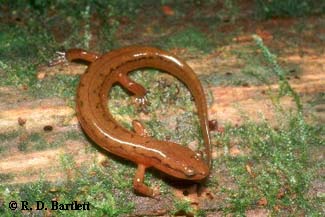
Eurycea junaluska
Natural Range and Habitat:
These salamanders are common inhabitants of springs, seepages, and small creeks throughout their ranges. Adults can be found under rocks, logs, leaves, and other debris both in and around water. Occasionally they can be found relatively far from running water in adjacent woodlands. Southern two-lined sals also inhabit saturated bottomland forests and floodplains along the coastal plains. Junaluska salamanders inhabit similar habitats, but can be found in relatively larger creeks.
Northern two lined salamanders range from New Brunswick and Quebec south to Virginia and as far west as Ohio. Southern two-lineds replace them westward to Illinois and then south to the coastal plains, but are absent from peninsular Florida. The Blue Ridge two-lined salamander is found only in the higher elevations of the Southern Appalachian Mountains of Tennessee, Virginia, North Carolina, and Georgia. The Junaluska salamander is restricted to only a handful of river drainages in extreme southwest North Carolina and adjacent Tennessee.
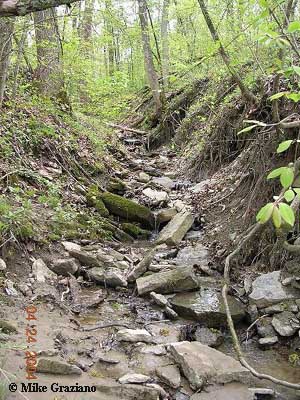
Habitat for E. cirrigera, E. longicauda, Plethodon cinereus, and
Plethodon richmondi in southwestern Ohio.
Housing:
All two-lined salamanders are easily kept in aquaria. The most difficult aspect of housing them is their ability to scale glass and slip through the smallest of gaps in the lid and filter apparatus. If you suspect a medium-sized housefly could escape your tank, then it is likely these salamanders could as well. Three or four of the diminutive adults can easily be housed in a 2.5-gallon (30 x 15 x 20 cm) tank.
The adults are essentially semi-aquatic, with some individuals remaining 100% aquatic. Therefore some land area will be required. It can consist of a few stacked rocks breaking the surface of the water or a more elaborate, planted land area. If a substrate is to be used, it is recommended that very fine gravel or sand is used. They readily tunnel into larger sizes of gravel and it becomes difficult to monitor their feeding, health, or even if they are still in the tank.
Water depth should be at least 2 cm (1 in) and seems ideal between 8 and 20 cm (3 to 8 in). While adults can be found both in shallower water and in deeper water (up to 18 m!) in the wild, neither extreme makes for a very practical setup in home aquaria. The water should also be flowing, and this is easily accomplished with an internal filter (the Duetto DJ50 is ideal) or vigorous aeration. Both bislineata and cirrigera seem very tolerant of a wide range of temperatures and so a range of 15-22°C suits them well. This should be lowered slightly in the winter to promote proper cycling and courtship behavior. Springs and seepages tend to be thermally stable microhabitats, so drastic reductions in winter temperatures are not really called for. E. wilderae on the other hand seems to be rather sensitive to temperatures over 20°C and so all efforts should be made to keep their water temperatures below that level.
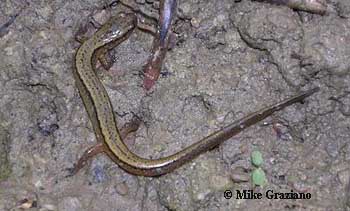 Eurycea cirrigera. |
 Eurycea cirrigera. |
Feeding:
In the wild, two-lined salamanders feed on a variety of aquatic and terrestrial invertebrates including millipedes, flies, spiders, ticks, earthworms, beetles, stonefly nymphs, and caddisfly larvae. In captivity, the most difficult problem is supplying food small enough for them to swallow. They will readily feed on finely chopped earthworms, live blackworms, whiteworms, and grindal worms, as well as prowl terrestrially for pinhead crickets, fruitflies, and springtails. Both adults and larvae can become surprisingly conditioned and can learn to beg for food.
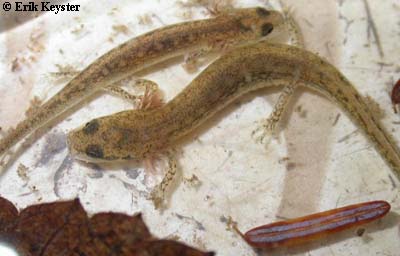 Eurycea cirrigera larvae. |
 Eurycea cirrigera leucistic larva. |
Breeding:
Breeding is known to occur in the wild from September through May and so regional variations in the timing of courtship and egg deposition are considerable. Courtship involves a "tail-straddle" walk that is typical of many Plethodontids. Upon contact with a female, males will nudge her to judge her receptivity. If she is receptive, she will follow the male while attempting to keep her chin pressed against the base of the male's tail as her forelimbs straddle his tail. She will follow him for up to an hour or more as he undulates his tail. Eventually, he will deposit a spermatophore which she will pick up in her vent and proceed to find a suitable place to lay her eggs. The eggs are often visible through the skin.
One interesting aspect to two-lined courtship is the use of teeth by the male. Sexually active males develop sharp, elongate premaxillary teeth which can pierce his lip. He uses these to lacerate the skin of females and rub pheromones from his mental gland directly into her body. These teeth are replaced by normal teeth after the breeding season and so they are not a practical way to distinguish between sexes. Males will also use these teeth to disrupt the courtship of other males, so one should carefully consider the sex ratios of adults if breeding is a goal.
Females prefer to lay their eggs (approximately 15-115 total) in a tightly-clustered, single layer on the undersides of rocks in flowing water. If rocks are not available, then roots, logs, leaves, or aquatic vegetation will be used. Females will usually remain with the eggs until hatching. The eggs hatch in 4-10 weeks depending on the temperature of the water, and the larvae hatch with all four limbs. They metamorphose within 1-2 years and become sexually mature in another 1-2 years. In captivity, this time can be reduced considerably with plentiful food.
Two-lined salamanders are rather easily bred in captivity with no special effort on the part of the owner other than acceptable temperatures and plentiful food. The larvae feed readily on small live foods such as bloodworms, blackworms, whiteworms, and grindal worms and are easily maintained with the methods used for larvae of newts.
 Eurycea wilderae gravid female. Yolks of eggs are visible through the skin. |
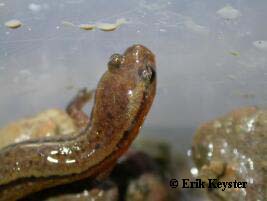 Eurycea cirrigera. Enlarged jaw muscles on the head indicate that this is a male. |
References:
Bahret, Roland. 1996. Ecology of lake dwelling Eurycea bislineata in the Shawangunk Mountains, New York. Journal of Herpetology. 30 (3):399-401.
Camp, Carlos D., Jeremy L. Marshall, Keli R. Landau, Richard M. Austin, Jr. and Stephen G. Tilley. 2000. Sympatric occurrence of two species of the two-lined salamander (Eurycea bislineata) complex. Copeia. 2000 (2):572-578.
Jacobs, Jeremy F. 1987. A preliminary investigation of geographic genetic variation and systematics of the two-lined salamander, Eurycea bislineata (Green). Herpetologica. 43 (4):423-446.
Kozak, Kenneth H. and Richard R. Montanucci. 2001. Genetic variation across a contact zone between montane and lowland forms of the Two-lined Salamander (Eurycea bislineata) species complex: a test of species limits. Copeia. 2001 (1):25-34.
Petranka, James W.; 1998, Salamanders of the United States and Canada, Smithsonian Institute Press, Washington.
Rose, Francis L. and Francis M. Bush. 1963. A new species of Eurycea (Amphibia: Caudata) from the southeastern United States. Tulane Studies in Zoology. 10 (2):121-128.
Ryan, Travis J. 1997. Larva of Eurycea junaluska (Amphibia: caudata: Plethodontidae), with comments on distribution. Copeia. 1997 (1):210-215.
Sever, D. M., H. A. Dundee and C. D. Sullivan. 1976. A new
Eurycea (Amphibia: Plethodontidae) from southwestern North
Carolina. Herpetologica. (32):26-29.
Written by N. Nelson, December 2003.

